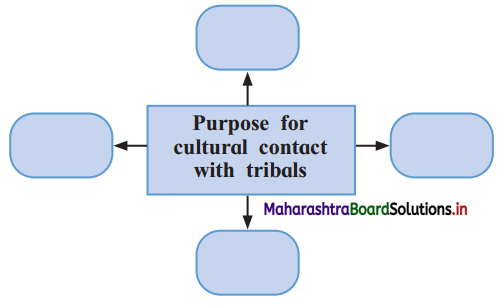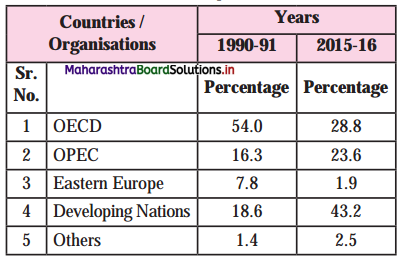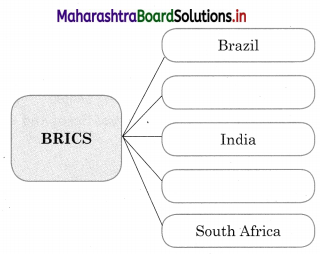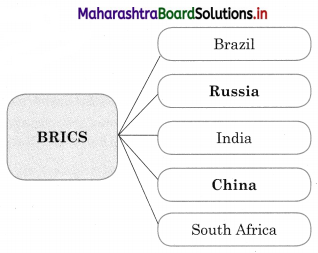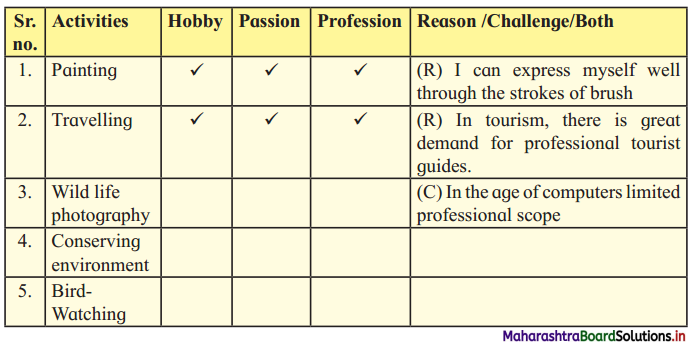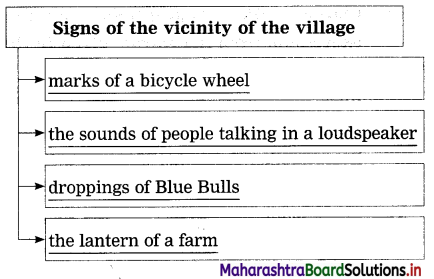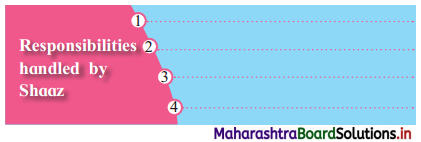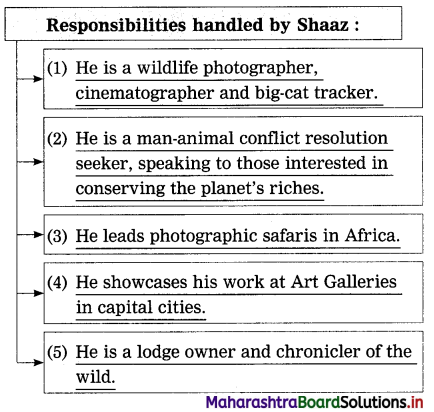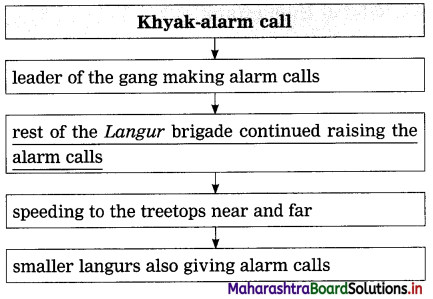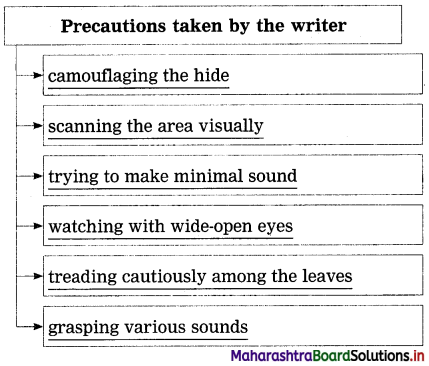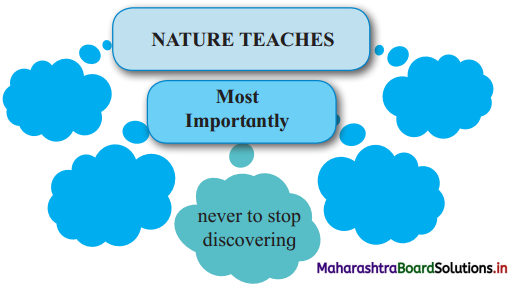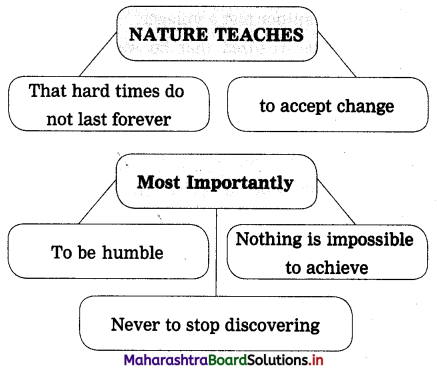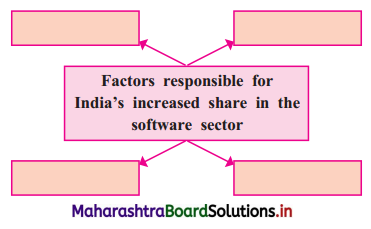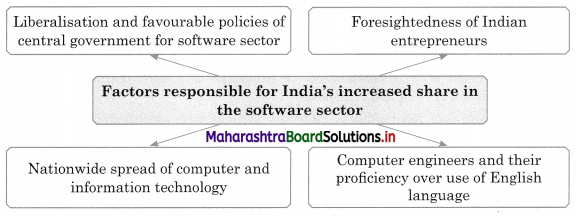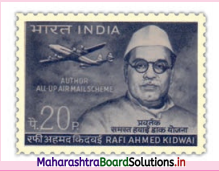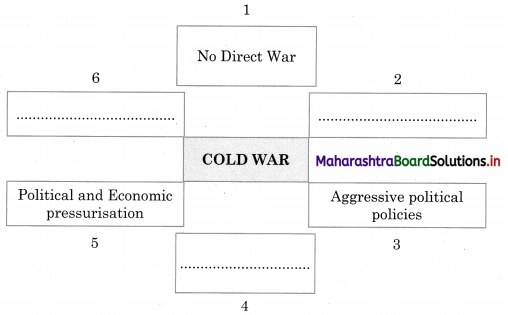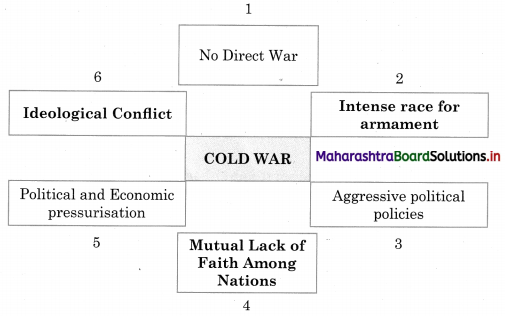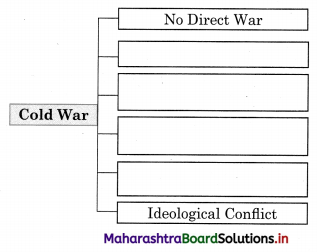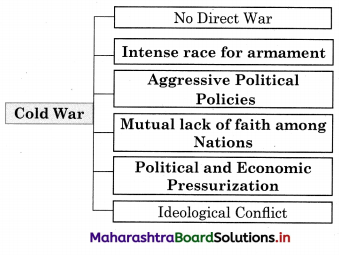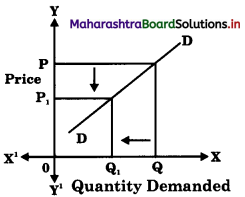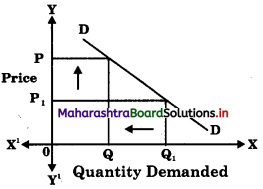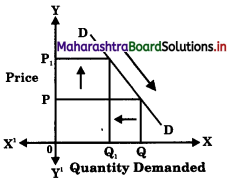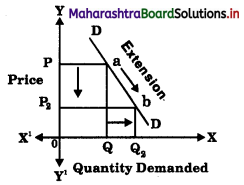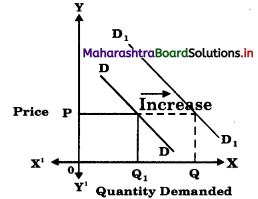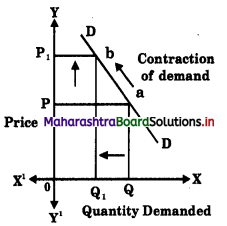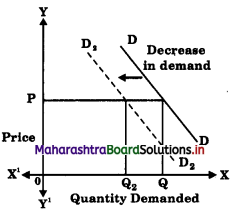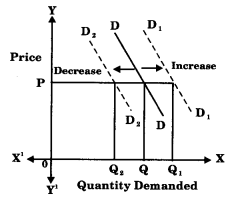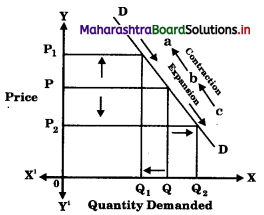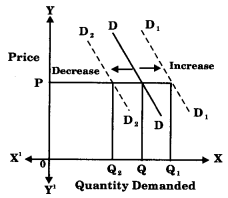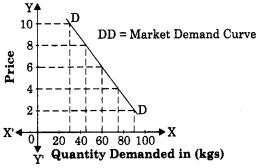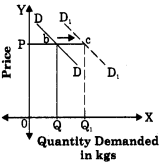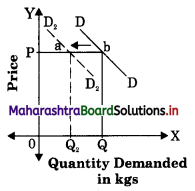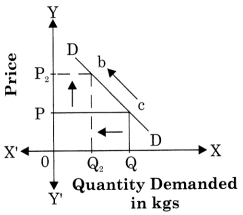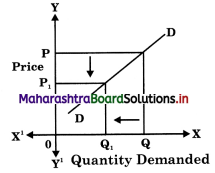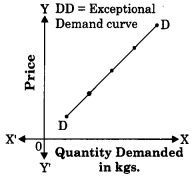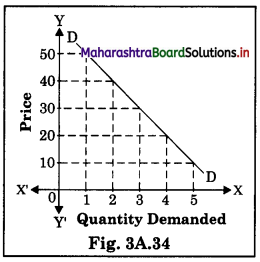Balbharti Maharashtra State Board Class 12 Sociology Important Questions Chapter 1 Introduction to Indian Society Important Questions and Answers.
Maharashtra State Board 12th Sociology Important Questions Chapter 1 Introduction to Indian Society
1A. Complete the following statements by choosing the correct alternative given in the brackets and rewrite it.
Question 1.
Law of _________ is also known as the law of cause and effect. (artha, dharma, karma)
Answer:
karma
Question 2.
_________ is the ultimate goal of salvation according to Hinduism. (Moksha, Artha, karma)
Answer:
Moksha

Question 3.
_________ refers to the acquisition of wealth through the path of righteousness through hard work. (Moksha, Artha, karma)
Answer:
Artha
Question 4.
Ahimsa and tapas are integral components of the _________ way of life. (Jain, Hindu, Buddhist)
Answer:
Jain
Question 5.
The society in the _________ Vedic period was less rigid with respect to occupation-based divisions. (Later, Early, Medieval)
Answer:
Early
Question 6.
_________ advocated an austere and strict lifestyle based on penance. (Jainism, Buddhism, Hinduism)
Answer:
Jainism
Question 7.
_________ is the sacred literature of Buddhism. (Puranas, Tripitkas, Vedas)
Answer:
Tripitkas
Question 8.
_________ promoted the spread of Buddhism across ancient Asia. (Akbar, Harshvardhan, Ashoka)
Answer:
Ashoka

Question 9.
The _________ period is the period of history of ancient peninsular India. (Ancient, Sangham, Vedic)
Answer:
Sangham
Question 10.
_________ do not permit proselytisation. (Zoroastrianism, Judaism, Islam)
Answer:
Zoroastrianism
Question 11.
The _________ movement brought religious reform in Hinduism during the medieval period. (Peasant, Tribal, Bhakti)
Answer:
Bhakti
Question 12.
Some important exponents of _________ are Kabir, Rahim and Guru Nanak. (Jainism, Sufism, Buddhism)
Answer:
Sufism
Question 13.
During the early Vedic period, those women who pursued their education until they were married were known as _________ (Sadyavadhu, Brahmavadinis, Sola Sati)
Answer:
Sadyavadhu
Question 14.
In the _________ Vedic period, the caste system became entrenched. (Early, Later, Medieval)
Answer:
Later
Question 15.
The _________ Vedic period witnessed a decline in the status of women in society. (Early, Later, Medieval)
Answer:
Later
Question 16.
_________ Jains believe that the principle of nudity is an essential element in the path of liberation. (Digambara, Swetambara, Hinayana)
Answer:
Digambara
Question 17.
The _________ learnt the art of warfare and administration. (Shudras, Kshatriyas, Brahmins)
Answer:
Kshatriyas

Question 18.
Education during the medieval period is centred on the _________ (Vedas, Bible, Quran)
Answer:
Quran
Question 19.
_________ included comprehensive study of the Quran. (Maktabs, Madrasas, Khanqahs)
Answer:
Madrasas
Question 20.
_________ literature makes reference to tribes and traditional castes. (Sangham, Vedic, Puranic)
Answer:
Sangham
Question 21.
_________ referred to the four stages in the life of a Hindu. (Purusharthas, Ashramvyavastha, Varna)
Answer:
Ashramvyavastha
Question 22.
Path of knowledge is _________ marg. (Bhatki, Jnana, Raja)
Answer:
Juana
Question 23.
Sadhus are people who choose the path of _________ (Bhatki, Jnana, Asceticism)
Answer:
Asceticism
Question 24.
The _________ Dynasty believed to be the “Golden Age”. (Maurya, Gupta, Kushan)
Answer:
Gupta
Question 25.
_________ wrote on astronomy and astrology during the classical period. (Aryabhatta, Varahamihira, Dhanvantri)
Answer:
Varahamihira

Question 26.
_________ wrote on medicine during the classical period. (Aryabhatta, Varahamihira, Dhanvantri)
Answer:
Dhanvantri
Question 27.
_________ wrote on geometry and cosmology. (Aryabhatta, Varahamihira, Dhanvantri)
Answer:
Aryabhatta
Question 28.
During the _________ society experienced a synthesis of Indian and Islamic culture. (Maurya dynasty, Gupta dynasty, Delhi Sultanate)
Answer:
Delhi Sultanate
Question 29.
_________ gave India a strong and stable political administration. (Akbar, Ashoka, Chandragupta Maurya)
Answer:
Akbar
Question 30.
_________ is referred to as first urbanisation. (Harappa, Mesopotamia, Malwa)
Answer:
Harappa
Question 31.
The small Indo-Aryan chieftaincies are called _________ (Mahajanpadas, Janapadas, Republics)
Answer:
Janapadas
Question 32.
In the year _________ the Suez Canal was opened to promote trade interests. (1869, 1969, 1828)
Answer:
1869
Question 33.
The _________ century saw the emergence of the Indian National Congress. (18th, 19th, 20th)
Answer:
19th
Question 34.
The abrogation of Article _________ in August 2019 gave special status to Jammu and Kashmir. (371, 370, 374)
Answer:
370

Question 35.
The Juvenile Justice Act was passed in the year _________ (2019, 2015, 2005)
Answer:
2015
Question 36.
The Transgender Persons Act was passed in the year _________ (2019, 2015, 2005)
Answer:
2019
1B. Correct the incorrect pair and rewrite it.
Question 1.
(a) Doing one’s duties – Dharma
(b) Sensuous pleasure – Kama
(c) Acquisition of wealth – Dharma
(d) Ultimate goal of salvation – Moksha
Answer:
(c) Acquisition of wealth – Artha
Question 2.
(a) Priests, teachers, intellectuals – Brahmin
(b) Rulers and warriors – Jajman
(c) Menial work – Shudra
(d) Traders, farmers – Vaishya
Answer:
(b) Rulers and warriors – Kshatriya
Question 3.
(a) Studenthood and celibacy – Brahmacharyaashram
(b) Householder – Grihasthashram
(c) Hermithood and retirement – Dharmashastras
(d) Renunciation – Sanyasashram
Answer:
(c) Hermithood and retirement – Vanaprasthashram
Question 4.
(a) Path of Knowledge – Moksha Marg
(b) Path of Devotion – Bhakti Marg
(c) Path of Meditation – Raja Marg
(d) Path of Action – Karma
Answer:
(a) Path of Knowledge – Jnana Marg

Question 5.
(a) Skyclad – Digambaras
(b) White clad – Shvetambaras
(c) Lesser vehicle – Hinayana
(d) Greater vehicle – Vajarayan
Answer:
(d) Greater vehicle – Mahayana
Question 6.
(a) Advisory and supervisory powers – Sangham priests
(b) Nomadic ballad singers – Khema
(c) Hunter and highway robbers – Vedars
(d) Warrior section – Marrakudi
Answer:
(b) Nomadic ballad singers – The Bards
Question 7.
(a) Sultans and their relatives – Aristocrats and nobles
(b) Ulemas and Brahmin – Peasants
(c) Urban wealthy merchants, traders – Townspeople
(d) Rural agriculturalists – Peasants
Answer:
(b) Ulemas and Brahmin – Priests
Question 8.
(a) Brahmo Samaj – Raja Rammohan Roy
(b) Arya Samaj – Swami Dayanand Saraswati
(c) Prathana Samaj – Mahatma Jyotirao Phule
(d) Harijan Sevak Sangh – Mahatma Gandhi
Answer:
(c) Prathana Samaj – Aatmaram Pandurang
Question 9.
(a) The Sati Prohibition Act – 1829
(b) The Indian Slavery Act – 1843
(c) The Caste Disabilities Removal Act – 1850
(d) The Hindu Widow Remarriage Act – 1870
Answer:
(c) The Hindu Widow Remarriage Act – 1856
1C. Identify the appropriate term from the given options in the box and rewrite it against the given statement.
Puranas, Purusharthas, Jati System, Vardhaman Mahavir, Sola Sati, Ardhamagadhi, Jainism, Holy Sabbath, Din-i-Ilahi, Langar, Brahmo Samaj, Social Legislations, Dr. B. R. Ambedkar, Viharas, Buddhism, Animism, Guru Granth Sahib, Lopamudra
Question 1.
Tribal belief system.
Answer:
Animism
Question 2.
Code of Conduct based on the Law of Karma.
Answer:
Puranas

Question 3.
The four aims of Hindu life.
Answer:
Purusharthas
Question 4.
It is based on the principle of “purity and pollution”.
Answer:
Jati system
Question 5.
24th Tirthankar of Jainism.
Answer:
Vardhaman Mahavir
Question 6.
The language of teachings of Mahavir.
Answer:
Ardhamagadhi
Question 7.
It advocated an austere and strict lifestyle based on penance.
Answer:
Jainism
Question 8.
It spread because of the patronage of the Mauryan emperor, Ashoka.
Answer:
Buddhism
Question 9.
A sacred observance of Jews.
Answer:
Holy Sabbath
Question 10.
A religion started by Akbar.
Answer:
Din-i-Ilahi
Question 11.
The sacred literature of Sikhs.
Answer:
Guru Granth Sahib
Question 12.
The Punjabi term for a community kitchen.
Answer:
Langar

Question 13.
One of the notable Vedic and Upanishadic woman scholars.
Answer:
Lopamudra
Question 14.
It highlights exemplary religious qualities which are emulated as role models by Jain women.
Answer:
‘Sola Sati’
Question 15.
Buddhist monasteries.
Answer:
Viharas
Question 16.
It refers to laws passed to promote social justice.
Answer:
Social Legislation
1D. Correct underlined words and complete the statement.
Question 1.
Widow remarriage was permitted in the Later Vedic period.
Answer:
Widow remarriage was permitted in the Early Vedic period.
Question 2.
The Yajur Veda states that “all classes have an equal right to study the Veda”.
Answer:
The Atharva Veda states that “all classes have an equal right to study the Veda”.
Question 3.
Those who never married and continued studying and imparting education throughout their lives were known as Sadyavadhu.
Answer:
Those who never married and continued studying and imparting education throughout their lives were known as Brahmavadinis.
Question 4.
Puducherry had gained prominence and formed the base of the Mauryan Empire.
Answer:
Magadha had gained prominence and formed the base of the Mauryan Empire.
Question 5.
The drainage system is one indicator of the collective life of the Harrapan people.
Answer:
The Great Bath is one indicator of the collective life of the Harrapan people.

Question 6.
Great Traditions include folk art, folklore, and the religious traditions of the local people.
Answer:
Little Traditions include folk art, folklore, and the religious traditions of the local people.
Question 7.
The period c.500 BCE to c.200 BCE is considered the period of First urbanization’.
Answer:
The period c.500 BCE to c.200 BCE is considered the period of Second urbanization’.
Question 8.
The Portuguese entered India for trade in the 17th century CE.
Answer:
The Portuguese entered India for trade in the 16th century CE.
Question 9.
The implementation of the Judiciary system during the time of the British was carried out on a traditional basis.
Answer:
The implementation of the Judiciary system during the time of the British was carried out on a secular basis.
Question 10.
The Wahabi Movement was the Initiative of Behramji Malabari.
Answer:
The Wahabi Movement was the Initiative of Syed Waliullah.
Question 11.
The Constituent Assembly of India was founded on 6th December 1947.
Answer:
The Constituent Assembly of India was founded on 6th December 1946.
Question 12.
The Female Infanticide Prevention Act was passed in the year 1870.
Answer:
The Female Infanticide Prevention Act was passed in the year 1872.
Question 13.
The Narcotic Drugs and Psychotropic Substances Act was enacted in the year 1920.
Answer:
The Narcotic Drugs and Psychotropic Substances Act was enacted in the year 1985.
Question 14.
The economic growth of India until recently was guided by Planned Development, through ten Five-Year Plans till 2017.
Answer:
The economic growth of India until recently was guided by Planned Development, through twelve Five-Year Plans till 2017.
2. Write short notes.
Question 1.
Education during the Later Vedic period.
Answer:
During the Later Vedic period, women were denied access to the Upanayana ceremony, which then denied them access to learning. There was an emphasis on the institution of sacrifice and this led to the growth of large amounts of literature related to sacrifice. The first millennium CE saw the disintegration of tribal units and chieftains were overthrown. In this situation of hopelessness emerges asceticism as a means for salvation from worldly life which was now preached by the Upanishads.
In eastern parts of India, there was the rise of free speculation and the emergence of humanitarian and theistic movements, which in turn led to new centers of spiritual leadership – the ascetics and wanderers (Sramanas or Parivrayakas) who rejected the authority of the Vedas and of Vedic priests. They criticized blood sacrifices which became a part of Brahminic ritual and gave importance to the practice of ahimsa or non-injury of living beings.

After Mahavir became a Kevalin (omniscient), a Jina (conqueror), and Mahavir (a great hero), he now became part of the sect called Nirgranthas, which came to be referred to as Jainas (following of Jina). Mahavir was a religious teacher for three decades.
Buddha borrowed and adapted from the popular beliefs of the region. The Buddhist system of education was conducted through Buddhist monasteries (viharas). The center of the Buddhist system of learning revolved around the Order (Sangh) of monks (bhikkus); later Buddha permitted the entry of women as nuns (bhikkhunis). Religious instruction was imparted in the viharas and like the Brahmanical system of education, there was a special relationship between the learner and teacher; the student had to live with the teacher (Upajjhaya or Acharya) and serve him.
Just as Vedic culture centred on sacrifices, Buddhist education and learning revolved around monasteries. Education in the Sangham period was a widespread social activity. It was a secular factor and not the privilege of any one community. Works on grammar, poetry, mathematics, astronomy, and fine arts (music, dance, drama, painting, sculpture), and architecture were the specializations.
The decline of Buddhist Viharas resulted in the decline of an organized system of education.
Question 2.
Nature of education during Medieval Period.
Answer:
Education during the Medieval Period is centred on the Quran. Without the ability to read and write, it would have been impossible to study the Quran, the Hadith, and other sciences. The Prophet Mohammed exhorts all people of faith to acquire knowledge.
However, unlike the previous systems of learning, there was no requirement for the strictness associated with Vedic schools nor renunciation (rejection) of the world. The Islamic system of education is open to all followers of the faith irrespective of one’s status.
Education was imparted in three ways:
- Maktab (for elementary education)
- Madrasa (for higher learning and generally attached to a mosque)
- Khanqah (theological training)
Maktabs had an age of admission around four years, which was marked by a religious ceremony. Early training focused on the R’s of learning – reading, recitation, writing, and arithmetic. The study of the Quran would start from around age seven.
Madrasas included a comprehensive study of the Quran and its commentary by established theologians alongside practical subjects like agriculture, accountancy, astrology, astronomy history, geography, mathematics, Islamic law and jurisprudence and statecraft i.e., the art of administration) and languages such as Arabic and Persian. Akbar enabled the study of Sanskrit and Upanishads for Hindu students who wished to learn at the Madrasa. The education was based upon the political, social and economic needs of the community at large. Students had the freedom to choose subjects according to one’s interests and their aims in life.

Post-madrasa training could be followed up by engaging the services of a learned teacher (for example, Abdul Qadir Badaoni, Abul Fazl, Faizi). Madrasas provided facilities for residence for both, students and teachers. In this regard, they were similar to Buddhist Viharas and temple colleges of South India from after the 7th century CE. Khanqahs can be linked to monasteries of Medieval Europe and they were often linked to the tombs of celebrated, much loved, and respected saints. These came to be regarded as Dargahs.
In the course of time, the arts themselves came to be influenced by the tast.es, ideas, and interests of the patrons, namely, Muslim rulers in Medieval India.
During the Medieval Period, education suffered a setback due to changed political circumstances. Educational work was carried out in the villages and towns by private individuals and institutions. The mediums of instruction were Sanskrit, Arabic, and Persian. Education, however, was made available to only a small section of people e.g., the elite and the ulema, the Brahmins, and a few upper caste groups. The education of girls was perceived as being a personal matter to be decided by their fathers or guardians. Women from the Muslim nobility were permitted to receive education in their homes at the hands of teachers who were presented with expensive gifts. Since, only a relatively small number of people belonging to the upper strata of society, it is reasonable to assume that the education of girls and women during the Medieval period was bleak.
Question 3.
Urbanisation during the ancient and medieval periods.
Answer:
The archaeological evidence from the Harappan civilization suggests that Harappa was indeed a well-planned town with a ‘way of life that can be referred to as ‘first urbanisation’. The city had a covered drainage system and a well-developed drainage system underground. The social conditions were well-advanced like other contemporary civilizations.
Towards the end of the Later Vedic period, after the pastoral and nomadic Indo-Aryans spread from Punjab to the Gangetic Plain; they deforested large areas of land to pave way for agriculture.
The period c.500 BCE to c.200 BCE is considered the period of ‘second urbanisation’ which brought a large-scale beginning of town life in the middle Gangetic basin. Magadha had gained prominence and formed the base of the Mauryan Empire.
Sixteen monarchies and “republics” known as Mahajanpadas, stretched across the Indo- Gangetic Plain from modern-day Afghanistan to Bengal and Maharashtra.
This period saw the second major rise of urbanism in India after the Harappan civilisation. Evidence for it comes through archaeological excavations, especially those of the Northern Black Polished Ware (NBPW) culture. Jain, Buddhist, and Sutra literature are among the important sources of information about cities and socio-political life of this period.
The beginning of coinage (metallic coins) started in this period. These cities became the centres of administration as well as of trade and commerce. This led to the emergence of city-based artisan and merchant guilds. A network of routes for internal and distant trade developed in both eastern and western regions. The position of ‘king’ gained much strength and respect the king was assisted by ministers and officials, who often came from the Brahmin and Kshatriya caste.
Question 4.
Religious beliefs and practices during the ancient and medieval periods.
Answer:
The impact of three ancient indigenous religions – Hinduism, Jainism, and Buddhism are significant especially up to the end of the Later Vedic period. The Vedic period is usually divided into – Early Vedic Period (c.1500 BCE to c.1000 BCE) and the Later Vedic Period (c.1000 BCE to c.500 BCE).

For Hindus, the Puranas and Dharmashastras laid out a Code of Conduct based on the Law of Karma (Action) rebirth, until it can attain moksha (salvation). The four aims of Hindu life (Purusharthas) are:
Jainism is said to have been revealed by 24 Tirthankaras of which Vardhaman Mahavir was the last. Similar to the Hindu Doctrine of Karma, Jain teachings are also based on the Theory of Karma. However, ahimsa (non-harming) and tapas (penance) are important and integral components of the Jain way of life. Buddha, with his teachings, advocated the middle path based on the Four Noble Truths and the Eightfold Path.
The Medieval Period (c. 650 CE – c. 1500 CE), saw several religions come to India from outside. These include Judaism, Christianity, Islam, and much later Zoroastrianism. The Sangham Period (6th century BCE to 3rd century CE) is the period of the history of ancient peninsular India.
The roots of Zoroastrianism are found in the Middle East region. People of the Jewish faith are believed to be one of the early foreign religions to come to India. It is in the 1st century CE that Saint Thomas, an Apostle of Jesus Christ, brought Christianity to the shores of Malabar in South India the essential foundation of the Christian faith is the principle of love and all Christians believe in the Death and Resurrection of Jesus Christ, their Saviour.
Islam first came to India in the 8th century CE, the impact and influence of the religion is seen only much later. Like Judaism and Christianity, Islam also preaches monotheism, and the faith centers on the Holy Quran. Muslims believe in the Five Pillars of Faith.
Sikhism emerged in the late 15th century CE and was founded by Guru Nanak (1469 CE – 1539 CE). Like Hinduism, Jainism, and Buddhism, Sikhism too preached the Karma theory.
The Bhakti Movement emerged with the need to bring religious reform in Hinduism during the medieval period.
Question 5.
The Islamic system of education.
Answer:
The Islamic system of education is open to all followers of the faith irrespective of one’s status.
Education was imparted in three ways:
- Maktab (for elementary education)
- Madrasa (for higher learning and generally attached to a mosque), and
- Khanqah (theological training)
Maktabs had an age of admission around four years, which was marked by a rite of entry. Early training focused on the R’s of learning – reading, recitation, writing, and arithmetic.

Several hours were spent on developing the art of writing. The study of the Quran would start from around age seven.
Madrasas included a comprehensive study of the Quran and its commentary by established theologians alongside practical subjects like agriculture, accountancy, astrology, astronomy, history, geography, mathematics, Islamic law and jurisprudence and statecraft (i.e., the art of administration) and languages such as Arabic and Persian (which were languages also taught elsewhere in the contemporary Islamic world). Noted scholar Abul Fazl informs us that Akbar enabled the study of Sanskrit and Upanishads for Hindu students who wished to learn at the Madrasa. The education was based upon the political, social and economic needs of the community at large students had the freedom to choose subjects according to one’s interests and their aims in life.
Khanqahs can be likened to monasteries of Medieval Europe and they were often linked to the tombs of celebrated, much loved, and respected saints. These came to be regarded as Dargahs.
Education of women: Muslim rulers at the imperial capitals at Delhi and Agra did not do anything remarkable for the promotion of the education of women.
The education of girls was perceived as being a personal matter to be decided by their fathers or guardians. Women from the Muslim nobility were permitted to receive education in their homes at the hands of teachers who were presented with expensive gifts.
Art: In the course of time, the arts themselves came to be influenced by the tastes, ideas, and interests of the patrons, namely, Muslim rulers in Medieval India. The mediums of instruction were Sanskrit, Arabic, and Persian. Education, however, was made available to only a small section of people e.g., the elite and the ulema, the Brahmins, and a few upper caste groups.
Question 6.
Zoroastrianism.
Answer:
The roots of Zoroastrianism are found in the Middle East region. Persecution of the people of this faith brought them to the Western coast of India, near present-day Gujarat, into which they culturally assimilated.
Zoroastrianism is the only outside religious community that still practices endogamy; it did not permit proselytization i.e., conversions into their faith. Fire temples are their place of worship and entry into their Fire temples is restricted to members of the community.
It is one of the world’s oldest and continuously practiced religions. It is centered on a dualistic cosmology of good and evil (Heaven and Hell).
Their sacred scripture is Avesta in which it is stated that the supreme creator is Ahura Mazda, from whom Asha (cosmic order) originates. Fire and clean water are agents of ritual purity. The Holy Flame was brought by priests from Persia to Navsari in Gujarat (c. 9th century CE).
While maintaining their strong sense of identity and culture, despite their diminishing numerical strength, Parsis has contributed in all walks of life.

Question 7.
Social life during the ancient and medieval periods.
Answer:
Harappan civilisation was known for its well-planned towns covered drainage system, its granary which was used for storing and trading surplus grain. The Great Bath is one indicator of the collective life of the people. Thus, there were peasants, artisans, traders, fishermen, priests, administrators, artists, weavers, etc.
Sangham literature makes reference to tribes and traditional castes. This indicates their coexistence. Though the Brahmins constituted a numerical minority, they played an important role in the development of Tamilian culture. Sangham priests though not dominating were in the process of assuming advisory and supervisory powers. The Bards (nomadic ballad singers) were a special class. Vedars (hunter and highway robbers) were much feared. The Marrakudi was a separate warrior section that had its own traditions and beliefs. Then, there were the fishermen, salt manufacturers, weavers, agriculturalists, shepherds, and cowherds who were also important.
The Varna System during the Vedic period referred to the social order or class of people. There was flexibility and fluidity with respect to occupation. It was only towards the end of the Vedic period that Varna turned into a rigid jati (caste) hierarchy based on the ideology of purity and pollution.
- Brahmin – priests, teachers, intellectuals
- Kshatriya – rulers, and warriors
- Vaishya – merchants, traders, farmers
- Shudra – menial work
The first three varnas began to call themselves the upper varnas. They became the ‘twice-born (dvija) because they were entitled to the initiation ceremony (upanayana).
Ashramvyavastha was prescribed for the so-called twice-born castes. This referred to the four stages in the life of a Hindu.
- Brahmacharyashram – Student hood, single status, and celibacy
- Grihasthashram – Householder
- Vanaprasthashram – hermithood and retirement.
- Sanyasashram – renunciation
The Classical Period (i.e. the period of the Gupta Dynasty) believed to be the ‘Golden Age, is when Indian society grew and thrived, setting the foundations in arts, science, politics, religion, philosophy, and economics that define Indian culture to this day. It became a global trade center arid an epicenter of artistic and intellectual achievement. Eventually, the smaller kingdoms broke away. This allowed the Huns of Central Asia to invade and defeat the Gupta dynasty around 550 CE and finally, the classical period declined by 650 CE.
Many texts (Nitishastras and Dharmashastras) were written during a period of ‘second urbanisation’, which elaborated on socio-political laws.

The Medieval Period of India witnessed the Muslim invasion of India’s material resources. During the Delhi Sultanate, society experienced a synthesis of Indian and Islamic culture Amir Khusro, used a form of Hindustani, which he called Hindavi. At the same time, the Delhi Sultanate was also responsible for the large-scale destruction and desecration of temples.
During this period also, a rigid caste system was followed. Efforts of Emperor Akbar gave India a strong and stable political administration.
The Medieval Period is often stated to be the darkest period in the history of India however, there emerged several changes that transformed Indian society also. Performing arts, architecture and sculpture flourished alongside internal and foreign trade and commerce. The establishment of Din-I-Ilahi by Akbar was a new religion based on ethical rationalism. Towards the 19th century CE there emerged a widening gap between liberals and orthodox groups from various faiths.
3. Write differences.
Question 1.
Status of women in the Early Vedic period and medieval period.
Answer:
| Status of women in the Early Vedic period | Status of women in the Medieval period |
| (i) Status: Indian women enjoyed a high status during the early Vedic period. | (i) Status: The status of women deteriorated in Medieval India. |
| (ii) Education: Women during the Early Vedic period had access to Vedic education. | (ii) Education: Only women from upper castes and aristocracy were given education in private. |
| (iii) Access of Knowledge: There were qualified women and some notable Vedic and Upanishadic women scholars during the early Vedic period. | (iii) Access of Knowledge: Knowledge of the scriptures and literacy was denied to Women and her status was reduced to being dependent on men. |
| (iv) Widow Remarriage: Widow remarriage was permitted in the Vedic period. | (iv) Widow Remarriage: Widow remarriage was considered taboo. |
| (v) Marriage: The main form of marriage was Monogamy and women in early Vedic marriage could marry late or decide not to marry. | (v) Marriage: Practices of child marriage, sati, and devadasi system, the customs of polygamy, and early marriage made women the objects of exploitation. |
| (vi) Freedom: Women were considered as useful and productive members of society and they were given the freedom to choose their life partners for marriage. | (vi) Freedom: Freedom of women was curtailed and was reduced to being dependent on men throughout her lifetime. |
Question 2.
Buddhism and Jainism.
Answer:
| Buddhism | Jainism |
| (i) Founder: The founder of Buddhism is Gautama Buddha. | (i) Founder: The founder of Jainism is Vardhaman Mahavir. |
| (ii) Teaching: The teachings of Gautam Buddha were in the language of the common people, Pali. | (ii) Teaching: The teachings of Mahavira were in the language of the common people, Ardhamagadhi. |
| (iii) Sacred books: The Sacred book of Buddhists is Tipitaka. | (iii) Sacred books: The Sacred books of Jains is Agamas. |
| (iv) Principles: Buddhism advocated the middle path based on the Four Noble Truths and the Eightfold Path. | (iv) Principles: Jainism preached (1) Ahimsa (2) Satya (3) Asteya (4) Aparigraha. |
4. Explain the following concepts with examples.
Question 1.
Social Reform Movements
Answer:
It was the educated Indians, often from the upper social strata, who campaigned the agenda for change at the micro-socio levels. The 19th century is witness to the emergence of many social and religious reform movements.
All these groups struggled to bring about changes at the local level in which they operated. They aimed in solving social problems which were socio-religious-cultural in nature.
They worked towards reforming obsolete, repressive, and regressive religious practices. The urge for reform was generated largely as a result of their interaction with the West.

Many groups worked to promote education among the ‘weaker sections – especially women and so-called lower castes. Organisations like the Arya Samaj aimed at restoring Vedic traditions and integrating Vedic knowledge with the modern curriculum.
Examples of some movements of social reforms:
- Brahmo Samaj – Raja Rammohan Roy
- Arya Samaj – Swami Dayanand Saraswati
- Prathana Samaj – Aatmaram Pandurang
- Harijan Sevak Sangh – Mahatma Gandhi
- Theosophical Society – Annie Besant
Question 2.
Westernisation
Answer:
Many of the educated elite took to the lifestyle of the British with respect to food habits, dressing, customs, mannerisms, attitudes, beliefs, language, sports, and entertainment, etc. Eminent Indian sociologist, M. N. Srinivas referred to this process of imitation of the British, as ‘Westerisation’.
The impact of Western culture has been classified into four types by Alatas. They are :
- eliminative changes (i.e., fading out of cultural elements)
- additive changes (i.e., new cultural additions)
- supportive changes (i.e., changes that support existing cultural traits)
- synthetic changes (i.e., the synthesis of old and new culture)
Examples: Drinking tea and coffee, changes in eating habits, using the dining table, crockery, and cutlery, hugging and kissing as a form was adopted universally, western sports like cricket, became popular.
5A. Complete the concept map.
Question 1.

Answer:

Question 2.

Answer:

Question 3.
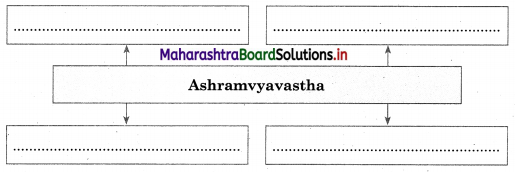
Answer:
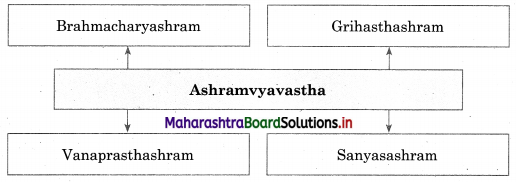
Question 4.

Answer:


Question 5.
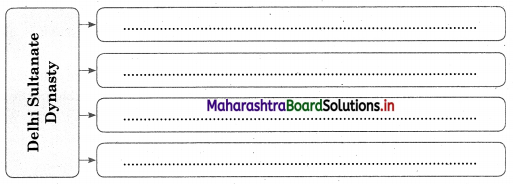
Answer:
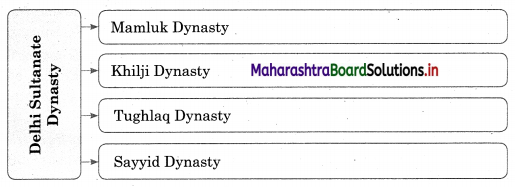
Question 6.

Answer:

5B. State whether the following statements are True or False with reasons.
Question 1.
The Bhakti Movement brought religious reform to Hinduism during the medieval period.
Answer:
This statement is True.
The Bhakti Movement rejected the caste system. It criticized excessive ritualism and advocated simplicity in worship. It professed that all human beings were equal in the eyes of God. The focus was on devotional singing and the repetition of his name.
Sufism also preached the unity of humanity and believed in the equality of all human beings in the eyes of God. Some important exponents of this are Kabir, Rahim, and Guru Nanak. Kabir and Rahim denounced external observances of religion such as rituals, superstitious practices, idolatry. Guru Nanak decried the caste system, ritualism, and idol worship.
Bhakti Movement in Maharashtra began in the 13th century CE with Dnyaneshwar. Namdev was his contemporary who criticized fasts, pilgrimages, and all other external forms of religious practices.
Question 2.
After Independence, the goals and programmes of the country have not seen many changes.
Answer:
This statement is False.
After Independence, the goals and programmes of the country have seen numerous changes. Some significant factors that have affected India after 1947.
Constitution of India:
- The Constitution of India was framed by the Constituent Assembly which was founded on 6th December 1946 to write the Constitution of India.
- The head of the Drafting Committee of the Constitution was Dr. B. R. Ambedkar.
- It is a document based on the strengths of the diversity of Indian society. It cherishes the goals of liberty, equality, and fraternity. It supports secularism.
- There have been numerous amendments to the Indian Constitution. A recent change has been the abrogation of Article 370 in August 2019 which gave special status to Jammu and Kashmir.
Economy: The economic growth of India recently was guided by Planned Development, through twelve Five-Year Plans till 2017. Each plan period has had its own objectives. It was in 1991, globalisation was introduced in India which has its share of positives and negative sides.

Since 2014, changes such as demonetization, single taxation policy under GST, welfare schemes, borderless trade practices, Swachh Bharat drives, promoting entrepreneurship, etc. have been key points.
Education: There has been a significant expansion of the number of anganwadis, schools, universities, deemed universities, autonomous institutions, IITs (Indian Institute of Technology), IIMs (Indian Institute of Management), IIITs (Indian Institute of Information Technology), NITs (National Institute of Technology), vocational programmes, open learning, online education, self-learning opportunities and so on.
- Enrolment numbers have been swelling beyond control in several cases.
- The number of teachers has also risen.
- The Draft New Education Policy has been formulated in 2019.
Question 3.
India is the most populous democracy in the world. –
Answer:
This statement is True.
In Post-Independent India, we have taken on a system of governance based on the principle of democracy. The three arms of government are the Executive, Assembly Legislature as well as Judiciary. We have the principle of democratic decentralization where power percolates down to the grassroots level.
The Indian political system no longer recognizes the former statuses of prince, nawab, raja or rani. All citizens are equal in the eyes of law. Modern India has embraced the principles and practice of free and fair elections. Voting rights are given to all citizens of India, on the attainment of age 18. India also has a multi-party system – and parties may be national, state or regional in character. Individuals also have the right to contest in elections. We also have a federal system of governance – Centre, and State/Union Territory.
The goals, policies, and agenda of each government are guided by its own principles or ideologies. There are differences and multiple views (for example, Left, Right, and Centre). The role of the opposition is the responsibility of keeping a check on the government in power. Consensus is an important value in a democratic society. Thus, India is the most populous democracy in the world.

6. Give your personal response.
Question 1.
India is a melting pot of culture.
Answer:
- India is a melting pot of many cultures and traditions, It is endowed with rich traditions of art, craft, culture, and cuisine, We have assimilated cultures of all civilizations that have come to our shores.
- Indian society is formed by the incorporation of culture followed by Indians since ancient times.
- Undoubtedly, Indian culture is one of the oldest existing cultures in the world. With each passing decade, it’s evolving.
- Western culture has also influenced Indian society. It has led to a few advancements, but at the same time, has caused Indians to disconnect from their roots rapidly.
7. Answer the following question in detail in about 150-200 words.
Question 1.
Discuss with relevant examples, consequences of Colonialism in India with respect to the following factors.
(i) Introduction of the new education system
(ii) Introduction of new administration system
(iii) Introduction of new7 economic system
(iv) Introduction of Transport and Communication
(v) Nationalist Movement
Answer:
(i) Introduction of the new education system: The British set up a system of education that had a far-reaching impact on Indian society. The medium of instruction in high school now became English. It became the common language of communication among the learned people. Schools and colleges were open to all individuals, irrespective of caste, creed, gender, etc.
The Indian Universities Act, 1856, enabled the establishment of the first universities in Calcutta, Bombay, and Madras. The content of education was secular – which included subjects like Mathematics, Science, Philosophy, Sociology, History, etc. This led to the rise of a new class of intelligentsia, who were of Indian origin but trained in ‘Western’ values customs, and practices. Some of them played a significant role in the reform movements. New values like rationality, equality, social justice, secular approach, and individualism gained firmer ground.
(ii) Introduction of new administration system: The British set in place new systems of administration. They started the system of services like the Economic Service, Education Service, Revenue Service, and Administrative Service. A new judiciary system was created, which took into consideration the earlier legal traditions of the Indian communities.
However, its implementation was carried out on a secular basis; each individual was judged on an equal basis, irrespective of one’s caste and creed. The authority of feudal lords and zamindars was abolished.
The Indian Councils Act, The Indian High Court Act, and The Indian Civil Service Act of 1861 all led to major changes in the Executive, Legislative and Judicial administration of India.
(iii) Introduction of new economic system: The economic system got transformed by industrial growth and its twin process of urbanization. Caste-based skills and occupations and, social relationships were gradually changing due to the impact of a changing economy and the rise of factories. The emergence of economic and educated classes was on the rise. New Revenue systems were started by the British in different parts of India which affected the peasants adversely.

(iv) Introduction of Transport and Communication: Systems of railways and roadways, and, Post and Telegraph offices were set up through the length and breadth of the country. These were ways in which it became possible to reach people in all parts of the country and access resources. In 1869, the Suez Canal was opened to promote trade interests. Development of transportation and communication led to an increase in market outlets for Indian raw materials.
(v) Nationalist Movement: Use of English as a common language of communication among. the educated elite played a significant role in networking, the nationalist movement received momentum. The awakening among the Indian masses against alien rule resulted in the call for the expulsion of the British from India and to fight for independence. The 19th century saw the emergence of the Indian National Congress and Mahatma Gandhi as the key figure in the call for independence.
![]()
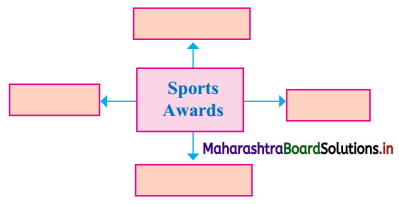

![]()
![]()
![]()
![]()
![]()
![]()
![]()
![]()
